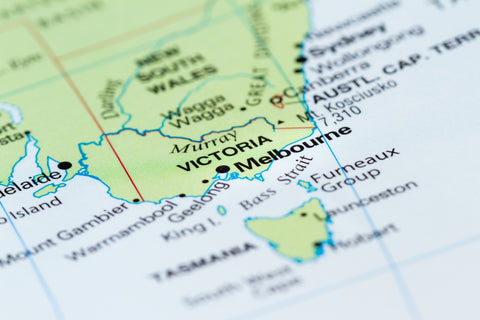There are more than 20,000 species of fly living in Australia. They live in all kinds of habitats, from dry to wet, cold to hot. The continent has the perfect set of habitats to allow them to breed and thrive.
These insects can irritate even the most patient of people as they interrupt daily life. They tend to find themselves around people, household pets, and food. While some people find them merely annoying, they can pose a health risk. Therefore, their populations must be controlled.
The key to this is understanding their lifecycle, behaviours, and the population at large. If you know these, you can learn ways to deter, kill, and control numbers.
In this article, we will explore the fly problem in Australia and how it can be controlled.
Types of Flies in Australia

There are 20,000 species of ly in Australia. But there are several that you’re more likely to find in Australia.
Blow Fly (Calliphoridae family)
A metallic blue fly that is between ¼” to ½” in length. They are a particularly quick species to mature, eggs can hatch within 18 hours and mature to adulthood within 7 days. They tend to live near dustbins where they scavenge on meat and rotting food. They are also known to be found around dead animals, such as rodents and birds.
Bush fly (Musca vetustissima)
A very small fly, often only 6mm long. They are a short-lived species, living just five weeks at most. They tend to lay eggs in faeces of animals such as dogs, cats, horses, and cows. They are very attracted to human sweat and will stay with a potential target for hours. They’re known to transmit eye infections in humans and livestock.
Cluster fly (Pollenia rudis)
The small olive-coloured fly has wings that overlap when at rest and is relatively sluggish in flight. The fly lays its eggs in the soil during late summer and these develop in earthworms, feeding on their hosts. They can often hibernate in a home.
Drain fly (Psychodidae family)
A very small, 2mm, fly that is tan-coloured. Wings are densely covered in hair. They have a short lifespan. Eggs hatch in one to six days, can mature in fifty days, and live for only a short period. They tend to be found around sludge-like organic matter.
Fermentation fly
These small flies are yellow-brown with bright red eyes. They’re a slow-flying species of fly, easy to catch. Females tend to lay about 500 eggs, which turn into adults within seven days. Adults only live for about two weeks. They are often found where fermenting residues can be found, or rotting fruit/vegetables.
Flesh fly (Sarcophagidae)
Up to 14mm long, this light grey fly can also appear to have a checkerboard appearance. Their lifecycle is very short, at just 2-4 weeks long. They are attracted to decaying waste, human foods, and excrement.
Fruit fly (Drosophila species)
A very small fly, just 3 mm in length is often a yellow-brown colour with bright red eyes. They are very slow fliers. These flies are found infesting fruit or hovering around fermenting residues at pubs.
House fly (Musca domestica)
The house fly is about 5-8 mm in length. It has a grey thorax with four narrow stripes with a buff or yellow abdomen. They breed in moist decaying vegetable matter, specifically in an uncovered dustbin. House flies tend to be found resting on walls, floors, and ceilings inside the house.
Lacewings (Chrysoperla carnea)
Lacewings are green as an adult, around 25 mm long. They have four large lacey transparent wings. They tend to live for only three to four weeks. The females can lay up to 600 eggs. They are typically found in gardens, orchards, and similar habitats, not often in the home.
March fly (Family Tabanidae)
These black to dark brown flies can reach sizes of approximately 25mm. They can resemble honey bees but only have one pair of wings. They are often found near creeks, streams, or tanks that can provide damp soils.
Horse Fly
Horse flies can be found in low lying pasture, brush and near streams and creaks where there is damp soil for their larvae to develop. They typically attempt to lay eggs inside livestock, which can result in significant injuries. They are a significant danger to anyone with large numbers of pets or other livestock.
Why Are There So Many Flies in Australia?

There are numerous reasons why there are so many flies in Australia.
Environmental factors contributing to fly populations
One of the first reasons why there are so many flies is because of the vast environmental factors that contribute to fly populations in the country. Flies, as a family, are rather versatile, able to survive in a range of habitats.
Still, there are numerous factors such as the soil type, warm weather, and humid conditions that are perfect for the breeding and living conditions of flies.
Seasonal variations in fly abundance
There are also seasonal variations that can contribute to fly populations. During the spring and summer months, you are more likely to find flies out and about, especially when food is plentiful. Some species might also be more abundant during the autumn season when fruit is dropping from the trees and this is the perfect food source for many species.
In addition, during the winter months, flies tend to hibernate. Therefore, you won’t see as many of them. That doesn’t mean that controls during this season should be stopped. These times are when cleaning attic spaces and other potential resting spots can help keep fly numbers down during the summer.
How to Avoid Flies in Australia

Avoiding flies in Australia is very important. It can reduce the number of diseases that are spread and it can help reduce food waste.
Effective fly-repellent methods
There are numerous fly-repellent methods available on the market. These can be chemically based or naturally based. One of the problems is identifying what flies are infesting your location. Some will work for specific species, others might be more general, but might not cover all species.
Some you can apply to you or you can apply as a general area deterrent. For example, there are sprays to put on your exposed arms and legs.
Outdoor activity tips
When outside, there are lots of tips that you can follow to reduce the chances of being caught by flies. For one, ensure that you spray with repellent. Also, you should reduce the time spent near key fly habitats, such as near waste locations, and lots of water.
Try to avoid times when flies are going to be more active as well.
Another consideration is to spend time near natural plants that repel flies, these include oregano, parsley, and thyme.
Home and hygiene practices
The product Fly Trap is in the picture
To control fly populations and stop them from passing on diseases, some very important home and hygiene practices are important to follow. For one all rubbish bins and waste collection should be covered. Flies are attracted to open waste, and an open bin outside is a good breeding ground for them.
Another key point is to cover all food in the home. When food is not required, it should be placed in the cupboards, fridge, or freezer for storage. When food is to be on the side but not being attended, it should be covered. There are fly covers available or use a dish with a lid.
Using fans inside the home can also be a good option. This makes it harder for many species to fly in the area, therefore, flies tend to avoid the home.
Finally, a good option is to use fly traps that can lure and kill the flies in your home. Traps will have a positive impact and reduce the numbers in the area, not just deter the fly from the area.
Why Are Flies So Bad in Australia?

Flies live in many different environments throughout the world. Humans and our activities offer excellent opportunities for the flies to thrive. We supply them with food and places to live and hibernate.
At the same time, the weather and the natural environment of Australia are perfect for flies. They have everything they need to thrive. Therefore, their populations can quickly grow to unmanageable sizes.
Impact of flies on daily life
Flies have numerous impacts on our daily lives. Not only are they a source of infections and disease, but they can also be a significant cause of food wastage, therefore, they can be a significant drain on the economy, costing millions of dollars per year.
They’re also known to cause disruption when large infestations can cancel events.
The role of flies in the ecosystem
Despite all the problems that flies cause us, they are an important part of the ecosystem. Their primary responsibility is to break down wastes that would otherwise grow mould and be a health hazard. They can also be an important food source for other animals, with everything from spiders to reptiles eating flies as a way to sustain themselves.
Therefore, while they might be a nuisance and a health risk, elimination from the wider ecosystem is not an option either.
Conclusion
It's important to know the risks associated with fly infestations. They can pass on numerous diseases, and they can be a pain. However, it is important to take steps to protect people from them. Ensuring that fly populations are controlled is the ultimate goal. Control means that their numbers are reduced to manageable levels, and not completely removed.












